1. What’s new in Mahara 18.04?¶
Mahara is being improved from version to version. On this page, you see the highlights for the latest release of Mahara.
You can see a list of all new features on Launchpad or check out the user-focused features via the  “New in Mahara 18.04” index entries.
“New in Mahara 18.04” index entries.
1.1. GDPR compliance¶
A number of new features support institutions to be compliant with the GDPR (General Data Protection Regulation), the new EU privacy regulation, effective 25 May 2018. It requires organizations to be stricter in protecting the personal privacy of EU residents.
The following enhancements were made in Mahara 18.04:
Everyone can be required to consent to the terms and conditions and the privacy statement of the site: This is the strict privacy mode.
If an institution has additional terms and conditions or privacy regulations to which its members need to consent when using the site, they can be dealt with on the institution level and members need to consent to them.
Whenever changes are made to the legal statements (terms and conditions and privacy statement), everyone affected by them needs to consent to the changed statement(s) when they log into the site the next time.
People can revoke their consent to any legal statement. That will result in a notification to the site or institution administrator for further communication. Additionally, the account will be suspended automatically.
A history of the legal statements is kept on the site level and the institution level and tracked who made the changes.
Everyone can delete their account (prior it was only possible for people self-registering and having internal authentication).
A report detailing when people consented to which legal statement.
Names and email addresses of deleted users are not kept in the system but replaced.
For more information, please refer to our privacy section.
1.2. Password policy¶
The password policy aims to assist people in choosing strong password for their accounts. It comes with a password strength indicator and mentions how long the password needs to be at minimum and what sort of characters are required.

Password policy in action with strength indicator¶
1.3. Copy portfolios in Leap2A formats¶
When a portfolio is copyable and available publicly or via a secret URL, the viewer can download it in the Leap2A format, which allows them to upload the portfolio to their own instance of Mahara.
This feature is useful for the copying of templates from one instance of Mahara to another.
1.4. Outsource files to object storage¶
Portfolios that contain media files can get large very quickly. If a site has many users, this can increase the storage requirements quite a bit. There are plugins available that allow the outsourcing of files to cloud object storage. Mahara 18.04 provides the infrastructure that makes the use of these plugins possible.
The object storage does not yet outsource generated image thumbnails, but all originals. Plugins are currently available for AWS S3 and Microsoft Azure Blob Storage. Depending on the cloud provider, you will need two plugins:
1.5. Link to an internal Mahara page¶
At times you may want to link to other portfolio pages within text. You can do so easily by selecting them when inserting a link rather than having to find their URLs. This functionality is available for personal portfolios.
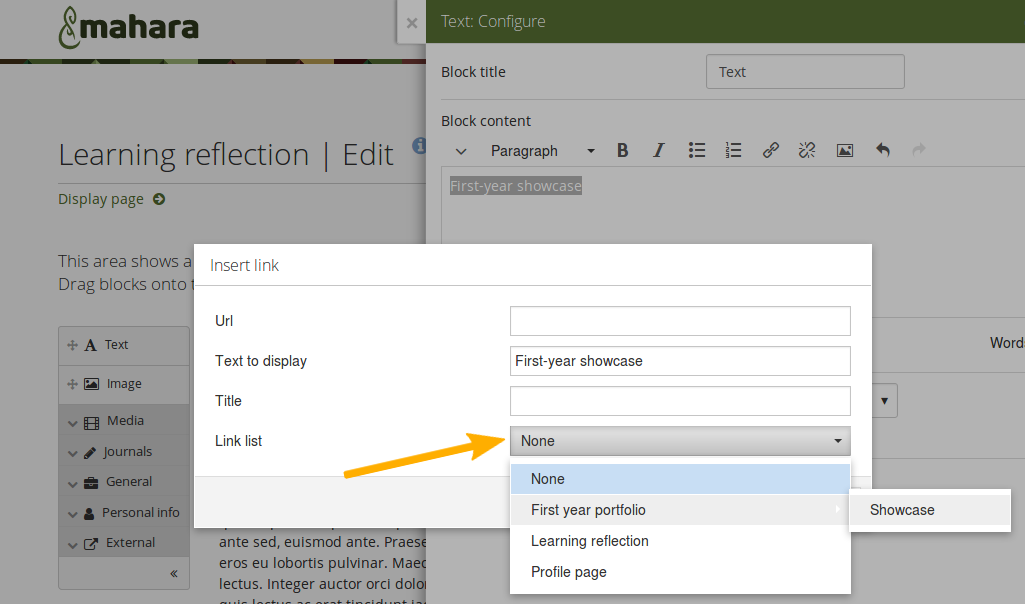
Insert a link to an internal page¶
1.6. Link to text within text¶
When you have a long journal entry or a note, you can set an anchor within the text to jump up or down within the text easily.

Insert an anchor in your text¶
1.7. Rotate images¶
When you upload images directly from a mobile device, the orientation may not be correct, and a landscape image might be displayed in portrait mode. By rotating the image in Mahara on the fly, you can correct its orientation.
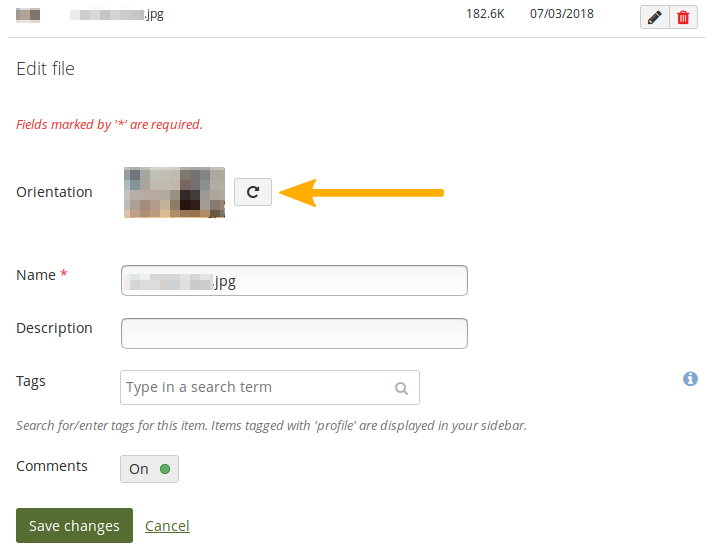
Rotate an image¶
1.9. Associate an institution with a group¶
When you create a group, it will be associated with the institution in which you are a member automatically. If you are a member in multiple institutions, you can choose the institution with which it shall be associated. This facilitates the managing of groups in particular in mutli-tenannted Mahara instances.
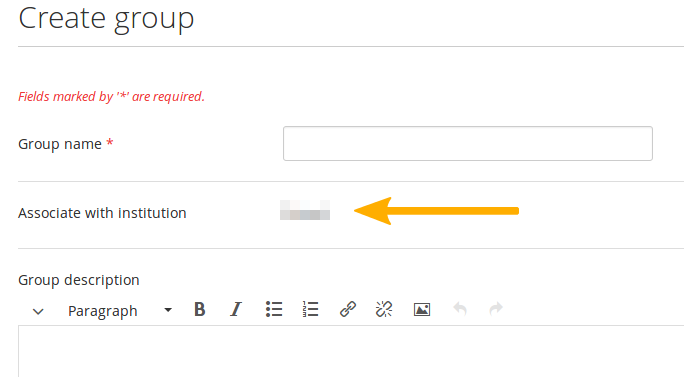
Associate an institution with a group¶
1.10. Decide which assessment statuses to display in SmartEvidence¶
You can decide which assessment statuses you want to display for each SmartEvidence framework. The setting is made in the administration area, and you can change it whenever you like.

Set the statuses to display for each SmartEvidence framework¶
Each status that you selected is displayed along with the number of items associated with it.
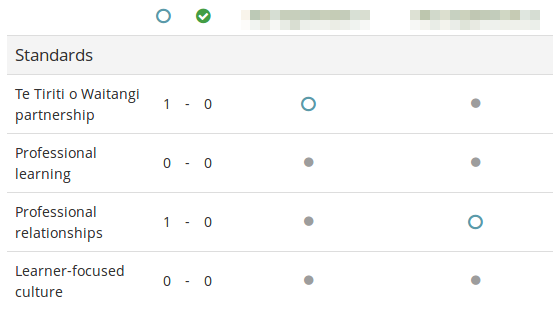
Display the assessment statuses in SmartEvidence¶
1.11. Automatic SAML metadata refresh¶
SAML metadata may change from time to time to ensure that it is still secure. Up to now the metadata needed to be changed manually whenever a change happened. However, it was difficult to know when an IdP made a change. Now metadata can be refreshed automatically when the refresh URL is provided. Then a cron job checks for any updates, and if it registers one, it replaces the mateadata so that users can continue to log in.
1.12. Modern date picker¶
The calendar widget for picking dates and times in Mahara was switched for a modern alternative. You can select both dates and times or still enter the date and time into the text field without using the calendar.
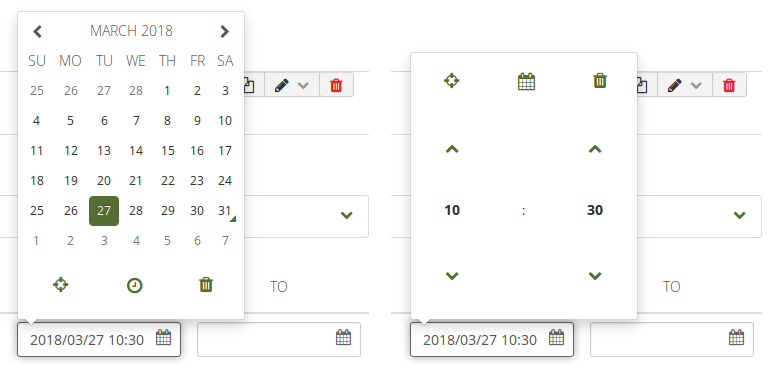
New calendar widget for picking dates and times¶
1.13. Make certain tasks faster¶
Certain tasks are made faster in Mahara by introducing changes on the backend. These are of particular interest to larger sites. Amongst them are:
Index sites running Elasticsearch via CLI.
Support session storage via Memcached (used to be an external plugin) and Redis
1.14. No more Flash¶
The last Flash-based component was replaced to use HTML5: The copy button for a secret URL. Now this copy function does not rely on Flash being installed on the device anymore.
1.15. Expiry of internal notifications¶
A site administrator can decide after how many days certain notifications expire automatically and are deleted from the inbox of a user. These notifications are:
Page access notifications
Watchlist notifications
Institution messages

